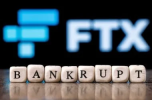- Date
- 16 November 2022
Navigating FTX's bankruptcy proceedings
Navigating FTX's bankruptcy proceedings
By Jake Rickman Image credit - Hasbi Sahin / Shutterstock.com |
What do you need to know this week?
Restructurings, insolvencies, and bankruptcies have featured prominently in our commercial articles as of late. This reflects the upsurge in companies facing financial distress around the world. The collapse of the crypto-exchange platform FTX, which has broadly dominated the commercial news headlines the past week, provides yet another opportunity to examine how insolvent businesses manage their (mis)fortunes.
As the Financial Times reports, following FTX’s blow up, FTX’s eccentric founder and (former?) billionaire Sam Bankman-Fried resigned last Friday, 11 November and legendary restructuring executive and bankruptcy lawyer John Ray III was appointed to manage FTX’s affairs. Mr Ray previously served as the executive liquidator of Enron following its historic collapse in 2001 after revelations of systematic fraud.
The same day, FTX filed for bankruptcy protection in the American state of Delaware, though the proceedings have not progressed past the initial filing.
Why is this important for your interviews?
We have explored what restructuring/insolvency law looks like generally before, but FTX’s collapse raises a special kind of restructuring law: financial institution insolvency.
From a legal perspective, there are three main purposes behind all insolvency proceedings, regardless of the debtor’s sector:
1. Minimise the number of parallel disputes and negotiations related to the insolvency;
2. Determine the legal rights in the business of all interested parties (i.e. shareholders and creditors) under the applicable insolvency regime(s); and
3. Establish a plan to either (a) rescue the business so it can keep trading, or (b) sell off its assets to repay creditors to the fullest extent possible.
Before a plan can be agreed upon, however, all the parties need to know as much as possible about the financial value of the company’s assets and liabilities. This is carried out by independent financial and accounting advisers. Likewise, legal advisers will evaluate the legal rights and obligations associated with the company’s assets and liabilities.
For non-financial institutions, this can be relatively straightforward, like in the case of a manufacturing company:
However, where the insolvent company is a financial institution, this becomes a much more challenging task because financial institutions have far more complex balance sheets (as well as unique regulatory obligations). For instance, a retail bank makes money by taking money from retail customers and lending it out at a higher rate of interest. Money held in a current account is treated as a liability, while the value of any loan the bank makes is an asset. The more complex the loan arrangements are the more complex the bank’s balance sheet becomes.
When a financial institution like a bank runs into financial trouble, untangling liabilities from assets can become quite difficult. FTX’s business model is akin to a retail bank. But consider that it deals primarily in cryptoassets — borrowing various cryptoassets from retail clients to lend out to others while also borrowing from other crypto-lenders to leverage its own returns. Due to the nature of cryptoassets and the fact that financial and legal advisers are less familiar with them, working out FTX’s balance sheet may prove exceptionally difficult.
Likewise, evidence of fraud will further increase the complexity of the restructuring.
How is this topic relevant to law firms?
NYC-based elite firm Sullivan & Cromwell, which represented FTX more generally, is expected to advise the company and its new leadership in the short term. However, if the judge appointed to the case is satisfied that a trustee should be appointed to manage the company’s affairs, it is likely these trustees will instruct separate counsel.
